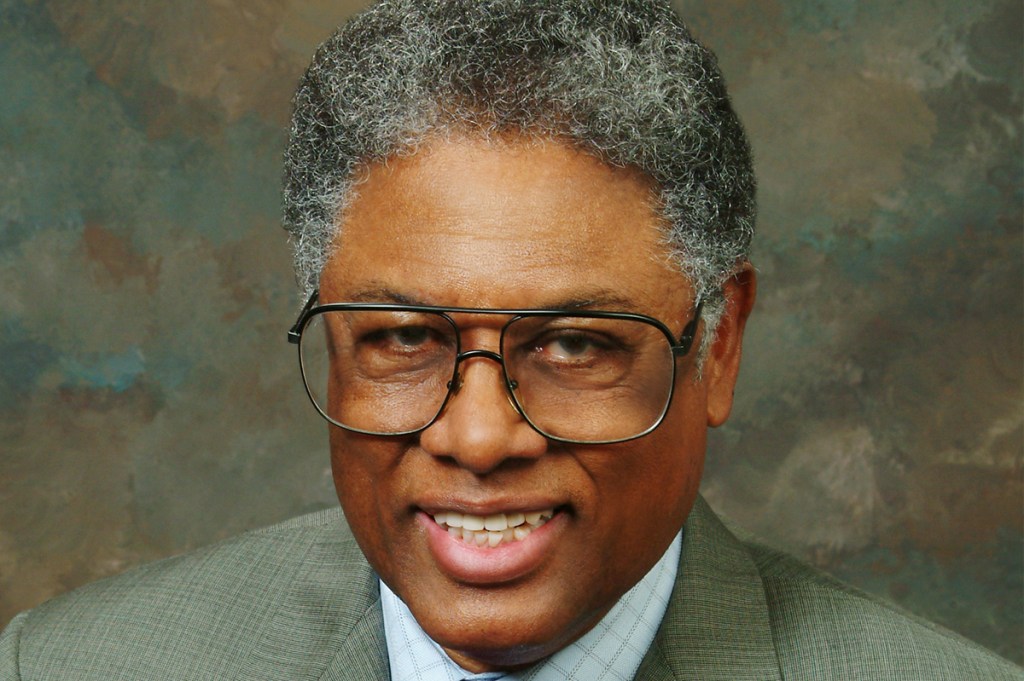New York socialist Zohran Mamdani is hailed as the social media sensation of American politics. He knows how to talk directly to young people, we’re told. Yet an account called “Thomas Sowell Quotes” has almost twice as many followers on X as Mamdani.
Sowell turned 95 this year. He is an unlikely influencer and yet hour-long interviews with him, published by Stanford’s Hoover Institution, have been watched millions of times. In his most popular video, Sowell argues for personal responsibility over dependence on the state and is meticulous in his use of empirical evidence. Black men who read newspapers and own library cards have had the same income as their white counterparts since 1969. Married black couples have the same poverty rate as white couples and have done for decades. And then comes the understated, Sowellian kicker. “Apparently lifestyle choices have consequences.”
This is Sowell at his intellectual finest, cutting through stupidity and receiving wisdom with precision. There are those, he argues, who have an unconstrained view of politics, in which elites can create a perfect world. Then there are realists like him, who accept that humans have flawed natures and that much about our lives is unknowable.
Those utopians are not just misguided but dangerous, harming the very people they hope to help. What follows from this relentless logic leads Sowell and his followers toward a kind of libertarian conservatism. We’re told that MAGA has killed the old Republican mantra of small government and free markets. And yet Sowell is more popular than ever.
I joined a recent celebration of his life at the Hoover Institution, watching as prominent conservatives and libertarians met to talk about his ideas and influence. There was a surprising amount of emotion as people discussed a man who has remained intensely private even in his role as a “public” intellectual. Sowell appeared in a brief video message from his office.
Those who know of Sowell know the official story. He was born in 1930 in the Jim Crow South and was raised in a house without electricity or running water. He was orphaned as a child, sent to live in racially segregated Harlem with his aunt and then, somehow, turned his life around. At 16 he dropped out of school and was hired by Western Union, delivering telegrams. Walking the streets, he watched New Yorkers and wondered why some lived in splendor while others led lives of squalor.
This question, one of social justice, led him to Harlem’s public libraries where he found the works of Karl Marx. Sowell joined the Marines during the Korean War, learned the value of discipline, left for the civil service in DC and night school. From there he made it into Harvard – and a life of research and argument. He is still a social justice warrior, not the shrill kind that he debates but a warrior armed with truth and reason.
During his time in Korea, Sowell learned how to use a camera and developed a love of photography. It seems appropriate for a man whose life has been about accurately representing the world. Back at the Hoover Institution, some attendees expressed surprise at an artistic display of his photography, featuring grand images of Yosemite and the Pyramids of Giza. Sowell is a man of many talents.
He has also seemingly met, mentored, or influenced every prominent black conservative you can think of, from Walter Williams to Shelby Steele to Supreme Court Justice Clarence Thomas. Thomas took the stage to share stories of his own deep friendship with the man. As a young student and an anarchist anti-war protester, Thomas said he once threw one of Sowell’s books into the trash out of furious disagreement.
He must have taken it out of the trash because, just a few years later, he met Sowell and, like a groupie, asked for his signature. The Supreme Court Justice told how Sowell’s thought has been like “an oasis in the desert,” inspiring him to stand against a sea of critics. Thomas had to pause at one moment, the room quiet as he tried not to be overwhelmed by emotion.
On stage, too, was Peter Robinson, a former speechwriter for Ronald Reagan, who reminded Thomas that he’d once toured his Supreme Court chambers and saw a large brass plaque etched with the Sowellian phrase from the Griswold decision: “Do not emanate into the penumbra.” When Robinson rushed with glee to tell Sowell about it, the economist replied: “I know – I gave Clarence that plaque.”
Robinson is now known as the bespectacled host of Hoover’s Uncommon Knowledge interview series, appearing in many of the most popular clips with the latter-day Sowell, teeing up quotes from the likes of Ta-Nehisi Coates for the wiser man to demolish. In one of the happy accidents of longform interviews, the interactions are easily clipped for the era of YouTube shorts, Instagram reels, even TikTok.
The format is repeated: Robinson poses a seemingly daunting, complicated question and Sowell responds by lacing a heater over the right-field wall (a chance he never got when, as a high-school dropout, he tried out for the Brooklyn Dodgers in 1948 – he failed the necessary fielding test). Sowell’s gift for the pointed jab can be traced back to his days as a student, when he admits he once described a classmate from England that he found particularly irritating as “nasty, British and short.”
Sowell’s acerbic intellect is a joy to watch; you can almost imagine his fans giggling as this gentleman in large-rimmed glasses and a sweater delivers pithy put-downs of (mostly) leftist ideas. There are also a quarter of a century of columns to read from too, for those not yet inured to the social media age. Of the Democratic socialists, he writes: “The fatal attraction of the government is that it allows busybodies to impose decisions on others without paying any price themselves. That enables them to act as if there were no price, even when there are ruinous prices paid by others.”
For the race-hustling reparation advocates: “Anyone who wants reparations based on history will have to gerrymander history very carefully. Otherwise, practically everybody would owe reparations to practically everybody else.”
For anyone in particular: “It is usually futile to try to talk facts and analysis to people who are enjoying a sense of moral superiority in their ignorance.” What disabused him of the Marxism of his youth? Facts and analysis, of course.
Sowell’s appeal is that he refuses to be confined to just one lane of commentary and he has no fear of controversial topics – particularly criticism of liberal weaponization of white guilt. Look, he says, armed with statistics and evidence, at the effect that well-meaning governments have on black Americans. He was scrutinizing the same arguments made by Ibram X. Kendi, Nikole Hannah-Jones and the 1619 Project decades before they made them.
Coleman Hughes, the young essayist known for his insights on race and culture, told of a conversation he’d recently had with his New York finance fiancée. “She said, ‘Did you know that the British Empire ended slavery?’” Hughes discovered that she, too, had seen Sowell’s videos on her timeline, delivering truth in the clear and certain tones of a well-read man.
For all his achievements, Sowell’s work has remained at the outskirts of the academy. Scottish historian Niall Ferguson told us that he learned about Scottish history from Sowell’s writings and yet says Sowell is “utterly exiled from graduate courses.”
Victor Davis Hanson, who also works at the Hoover Institution and has lunched with the man every week for decades, says Sowell has a way of infuriating those who object to his views. “Tom understands how much he frustrates people simply by force of experience.” The irony is that Sowell’s rejection by academia has coincided with an explosion of his commentary as it reaches new generations and an online audience.
Hughes said the appeal of Sowell in this era of social media is partly down to his distrust for the established intelligentsia and his rejection of its convoluted language. “The expert class bamboozles with big words. Sowell despises that and expresses it in these direct terms,” Hughes says. “Sowell cuts through the noise with deep insight, straight to the point.”
For an author whose books would weigh down even a strong back, Sowell’s aphoristic style fits the era of short attention spans. Even at 95, his charm and intelligence are enough to intimidate his academic foes and inspirational enough to make Clarence Thomas cry.
This article was originally published in The Spectator’s November 10, 2025 World edition.


























Leave a Reply